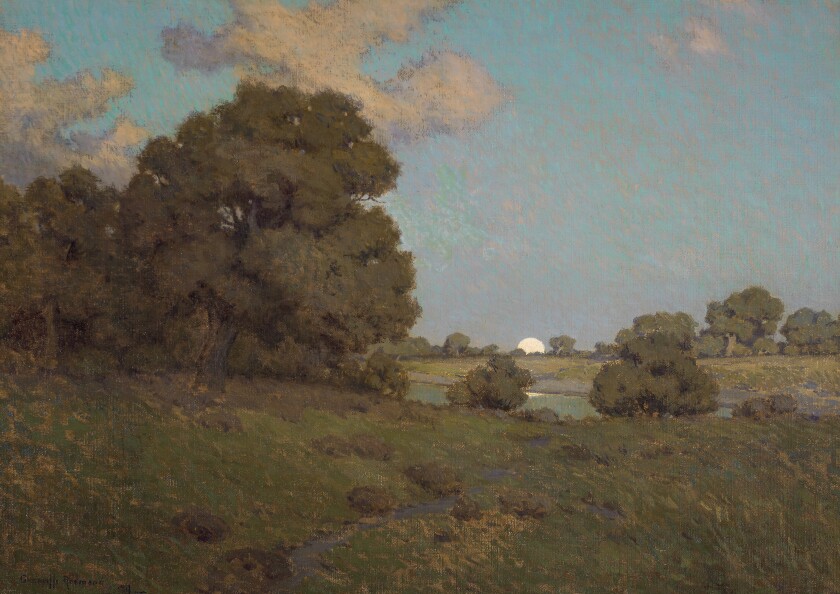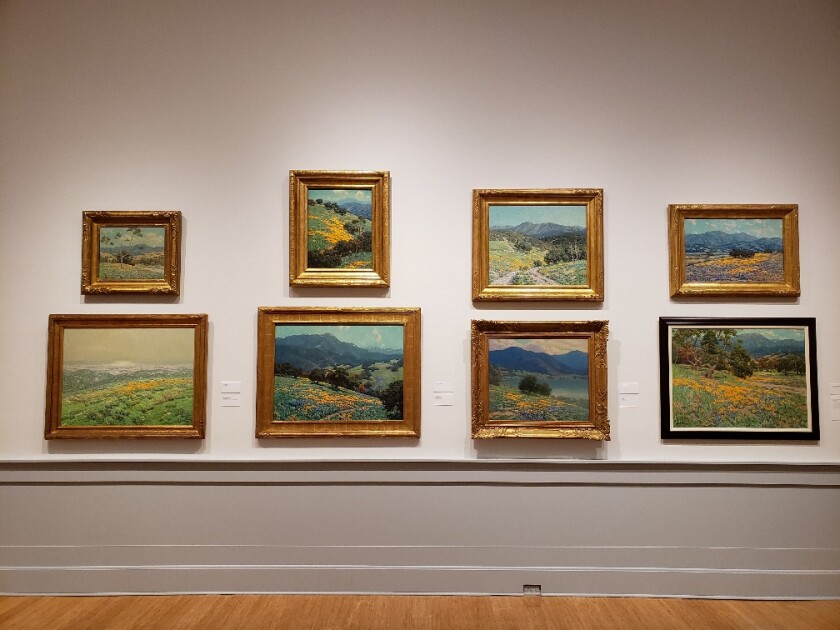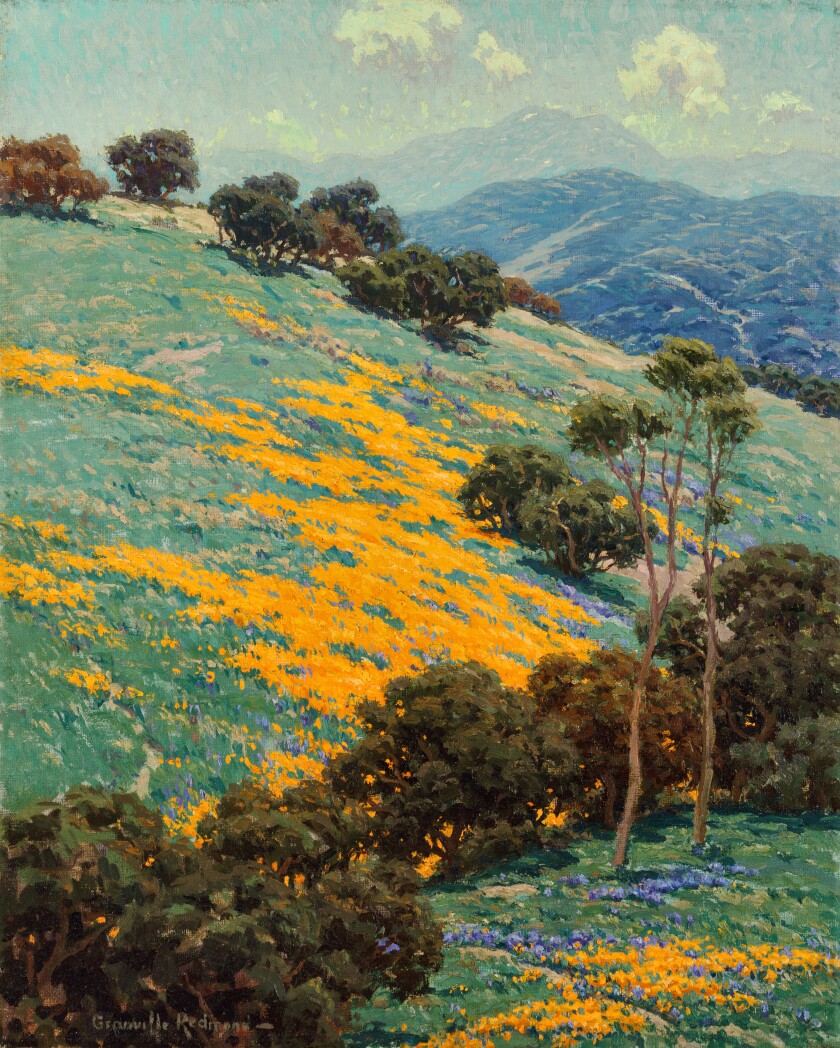As an extravagantly talented artist, one whose facility with a brush is obvious from first look, Granville Redmond (1871-1935) is a peculiar case. His vividly colored landscapes and moody twilight and nighttime scenes are often lovely, if old-fashioned for their time. But his extraordinary biography finally commands more attention than his canvases.
Believe it or not, without Redmond, Charlie Chaplin might not be exactly the genius of silent pictures that we know today.

Granville Redmond, “Moonlight, San Mateo Salt Marshes,” 1911, oil on canvas
(Laguna Art Museum)
The painter had modest roles in eight Chaplin films, starting with “A Dog’s Life” (1918), the first picture the Little Tramp made for First National, his own production company, and concluding with the 1931 classic, “City Lights,” one of the actor’s best. (Uncredited, Redmond plays the sculptor in the famous opening scene, where the Tramp is unveiled snoozing in the arms of a monument at its public dedication ceremony.) While the brilliant mime was of course a major star by the time the two met, his long friendship with the artist had a lasting impact on his cinematic achievement.
At the Laguna Art Museum, recently reopened to limited numbers of visitors with appropriate requirements for masking and social distancing in light of the pandemic, a traveling retrospective brings together 74 paintings. “Granville Redmond: The Eloquent Palette” was organized by the Crocker Art Museum in Sacramento. Originally scheduled to close Sept. 20, it has been extended through Nov. 15. (The loan for one painting, “Hillside in Spring,” was not retained.) This is the artist’s second survey to be shown at Laguna — the first was in 1989 — the seaside colony where Redmond worked at the start of the 20th century.

Granville Redmond is known for his poppy paintings, which weren’t his favorite
(Christopher Knight / Los Angeles Times)
Mostly Redmond lived and worked in and around Los Angeles, with stints in Northern California. Study in Paris, however, set the path he would follow throughout his career. In 1893, when he was 22, Redmond enrolled at the Académie Julian, a rigorous private art school there popular with international students.
He stayed in Paris for nearly five years. In the exhibition, the soft, gray and brown twilight views of meadows and California oak trees suggest Redmond’s affinity for tonalism, a low-key technique of atmospheric painting that he learned from intimate interaction with French paintings of the Barbizon forest, as well as northeast American landscapes by painters like George Inness.
The style was well-established in France. Redmond loved it, but buyers in California didn’t. Too melancholy, perhaps. They preferred color — bright, showy, rolling fields of golden poppies and lupines, the flowers’ yellow-orange and purplish-blue hues setting off complementary sparks on the optical color wheel.
Often this style is referred to as California Impressionism. The French kind, born in the 1870s and controversial from the get-go, had long been superseded by the time Redmond picked it up almost two generations later, in the 1910s.
In France it was partly an inventive, highly personal reaction to tumultuous urban industrialization. But in California it functioned almost as idyllic promotion of Golden State bliss. Redmond’s version is often anchored by an underlying geometry, like a net thrown over undulating hills, slopes layered like identical successive waves rolling into shore.
It’s as if nature is being corralled by an unseen structural grid made by art. The technique no doubt derived from the orderly training process at the Académie Julian.
That sort of rigid process is what French Impressionism sought to undermine. The colorful, broken brushwork of a Claude Monet or an Alfred Sisley landscape came from elevating the spontaneity of the rapid oil sketch, which the academy regarded as only the first of many steps in creating a finished painting. By contrast, Redmond’s broken brushwork is careful, measured and highly organized — anything but spontaneous and free.
In fact, I think of the American painter’s flamboyant landscapes as a continuation of tonalism by other means — vivid and highly colored, rather than muted and bronzed. The optical fireworks of the thickly daubed surfaces are held in check by almost mathematically charted compositions. It’s as if a smooth, placid, sepia-toned picture were being infused with thick color.
Sometimes Redmond attempted a frank fusion of tonalist atmosphere and deep color. A number of moonlight seascapes are saturated edge to edge in sapphire blue, flecked with almost pure white paint to suggest light reflected on the water’s surface. Shown together in one room whose walls are also painted solid sapphire, nighttime on the ocean verges on creepy.
The buying public responded positively to these chromatic spectacles, somewhat to Redmond’s dismay. He complained that he could hardly give away the subtler tonalist paintings, which he regarded as his finest work, while the demand for flashy poppy paintings was high.
The Laguna show is pretty evenly divided between the two types. Installed in a loose chronology, they intermix.
The chronology is loose, however, because Redmond often didn’t date his pictures. Educated guesswork is involved in organizing the sequence. The excellent, exhaustively detailed catalog by Crocker curator Scott A. Shields makes reasonable efforts to line things up.

Granville Redmond, “California Poppies,” no date, oil on canvas
(Laguna Art Museum)
What’s remarkable about Redmond’s biography is his personal tenacity and fearless creativity in making a full life for himself. Struck with scarlet fever at the age of 2, he had been rendered deaf and mute.
At the California School for the Deaf, then in Berkeley, now in Fremont, he found a supportive staff — including for his budding artistic skills. When he set out to cross both a continent and an ocean for ambitious study in Paris, he went alone. He made his way through art school. When he returned to Los Angeles, he married, had children and became one of the most popular painters in the state.
He also put his highly developed skills in sign language and pantomime to good use in the newly flourishing industry of silent movies. Chaplin was impressed. They became fast friends. The actor bought Redmond’s paintings, and he introduced them to other Hollywood heavyweights.
Past literature on Redmond is marked by ill-informed speculation that his deafness enhanced his vision, as if loss of one sense found compensation in another and translated naturally into painterly skill. The Laguna show demonstrates otherwise. Redmond was not a great artist, but he was a very good one. His achievement should be admired for what it is.
Laguna Art Museum, 307 Cliff Dr., Laguna Beach, (949) 494-8971, through Nov. 15. Closed Weds.
'Granville Redmond: The Eloquent Palette'
Where: Laguna Art Museum, 307 Cliff Drive, Laguna Beach
When: Through Nov. 15. Closed Wednesdays
Admission: $5-$7 (17 and younger are free). Advance tickets with timed entry required
Info: (949) 494-8971, lagunaartmuseum.org
tinyurlis.gdu.nuclck.ruulvis.netshrtco.de
مقالات مشابه
- برج خنک کننده Sheet Cheet
- دادگاه اروپایی پشت pro-فلسطینی BDS جنبش اعتراضی
- شواهد قوی زلزله گسل اجرا از طریق سایت هالیوود, آسمان خراش ها, دولت می گوید
- آخرین: ساکنان هجوم آوردند به سایت های گردشگری در چین
- گرفتن یک coronavirus آزمون در حال تبدیل شدن سخت تر و خسته کننده و اضطراب معترضان
- در اینجا چیزی است که در Whittlese امروز انتظار می رود
- کتاب مقدس که نادیده گرفته AG سفارشات در حال حاضر یک COVID-19 شیوع
- ویکتوریا 1608 مورد ابتلا به کووید و دو مورد مرگ را ثبت کرد
- "سابقه ای خطرناک ایجاد کنید": پیشنهاد دیرهنگام نواک برای توقف اخراج
- ساعت بن تن پروژکتوری سخنگو خرید ارزان |فروشگاه من و تو خرید